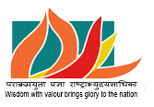- Namaste! I am glad to join this conversation on textiles. I am also happy to see people from different countries participate here. The Indian Council for Cultural Relations and Uttar Pradesh Institute of Design have made great efforts to bring everyone together.
- You have picked a great theme- “Weaving Relations: Textile Traditions. Friends, Our link with the textile sector goes back centuries. In the textile sector you can see our history, our diversity and immense opportunity.
- Friends, India has textile traditions that are very old. We were one of the earliest to spin, weave and dye cotton. Naturally coloured cotton has a long and glorious history in India.
- The same is said about silk. Friends, The diversity in our textiles shows the richness of our culture. Go to every state. Go to every village. Go among different communities.
- There will be something unique about their textile traditions. If Andhra Pradesh has the Kalamkari, Muga Silk is Assam’s pride. Kashmir is home to the Pashmina, Phulakri’s add pride to Punjab’s culture.
- If Gujarat is famous for Patolas, Banaras has made a mark for its Saris. There is Chanderi fabric in Madhya Pradesh and vibrant Sambalpuri Fabric in Odisha. I have just named a few.
- There are many many more. I also want to draw your attention to the rich textile traditions of our tribal communities. In all of India’s textile traditions: There is colour. There is vibrancy. There is eye for detail.
- Friends, Textile sector has always brought opportunities. Domestically, textiles sector is among the highest job providers in India. Internationally, Textiles helped us to build trade and cultural relations with the World.
- Afterall, Indian textiles are highly valued globally. They have also got enriched with customs, crafts, products and techniques of other cultures.
- Friends, This Program is also in context of Gandhi ji’s 150th Birth Anniversary celebrations. Mahatma Gandhi saw a close link between the textile sector and social empowerment.
- He converted the simple Charkha into a key symbol of India’s independence movement. The Charkha wove us together as one nation.
- Friends, Today we look at Textiles as a key sector that will help us build an आत्मनिर्भर भारत or self-reliant India. Our Government is particularly focussing on: Skills upgradation, Financial assistance, Integrating the sector with latest technology.
- We are assisting our weavers to help them continue to make world class products. For that: We want to learn global best practices.
- We also want the world to learn our best practices. That is why, it is good to see eleven nations participate in today’s conversation. The exchange of ideas and sharing of best practices will create new avenues for collaboration .
- Friends, World over, the textile sector employs many women. Thus, a vibrant textile sector will add strength to efforts of women empowerment. Friends, We need to prepare for our future in challenging times.
- Our textile traditions have showcased powerful ideas and principles. They include: Diversity and adaptability. Self-reliance. Skill and innovation. These principles have become even more relevant now.
- I hope that the programs like today’s webinar, will contribute to further reinforcing these ideas. I also hope it will contribute to a more vibrant textile sector. I wish ICCR, UPID and all participants all the best in this effort. Thank you very much!
(The views expressed are the author's own and do not necessarily reflect the position of the organisation)

